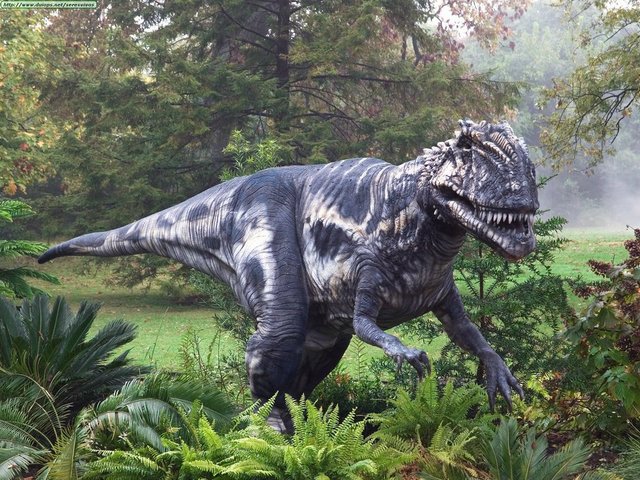Post by dinosauria101 on Apr 21, 2019 16:35:54 GMT 5
Deinonychus antirrhopus (pack of 6-8)
Based on the few fully mature specimens, Deinonychus could reach 4 metres (13 ft) in length, with a a weight of 100 kg (220 lb). Its skull was equipped with powerful jaws lined with around sixty curved, blade-like teeth. Studies of the skull have progressed a great deal over the decades. Ostrom reconstructed the partial, imperfectly preserved, skulls that he had as triangular, broad, and fairly similar to Allosaurus. Additional Deinonychus skull material and closely related species found with good 3D preservation show that the palate was more vaulted than Ostrom thought, making the snout far narrower, while the jugals flared broadly, giving greater stereoscopic vision. The skull of Deinonychus was different from that of Velociraptor, however, in that it had a more robust skull roof like that of Dromaeosaurus, and did not have the depressed nasals of Velociraptor. Both the skull and the lower jaw had fenestrae (skull openings) which reduced the weight of the skull. In Deinonychus, the antorbital fenestra, a skull opening between the eye and nostril, was particularly large.

Megalosaurus bucklandii
Megalosaurus (meaning "Great Lizard", from Greek, μεγαλο-/megalo- meaning 'big', 'tall' or 'great' and σαυρος/sauros meaning 'lizard') is a genus of large meat-eating theropod dinosaurs of the Middle Jurassic period (Bathonian stage, 166 million years ago) of Europe (Southern England, France, Portugal). It is significant as the first genus of dinosaur (outside of birds) to be described and named. n many ways, Megalosaurus was your garden-variety theropod dinosaur, indistinguishable from a host of other big-headed, large-toothed carnivores of the late Jurassic period. What really sets this predator apart is the fact that it was the first dinosaur ever to be discovered and named: a fossilized femur of Megalosaurus was dug up in England in 1676, but it wasn't until 150 years later--after further discoveries--that it was given its name, Greek for "great lizard," by the early paleontologist William Buckland. Size about 30 feet long with weight estimates varying from 700 kg (1,500 lbs) to 1,100 kg (2,400 lbs).

Credit to Wikipedia
Based on the few fully mature specimens, Deinonychus could reach 4 metres (13 ft) in length, with a a weight of 100 kg (220 lb). Its skull was equipped with powerful jaws lined with around sixty curved, blade-like teeth. Studies of the skull have progressed a great deal over the decades. Ostrom reconstructed the partial, imperfectly preserved, skulls that he had as triangular, broad, and fairly similar to Allosaurus. Additional Deinonychus skull material and closely related species found with good 3D preservation show that the palate was more vaulted than Ostrom thought, making the snout far narrower, while the jugals flared broadly, giving greater stereoscopic vision. The skull of Deinonychus was different from that of Velociraptor, however, in that it had a more robust skull roof like that of Dromaeosaurus, and did not have the depressed nasals of Velociraptor. Both the skull and the lower jaw had fenestrae (skull openings) which reduced the weight of the skull. In Deinonychus, the antorbital fenestra, a skull opening between the eye and nostril, was particularly large.

Megalosaurus bucklandii
Megalosaurus (meaning "Great Lizard", from Greek, μεγαλο-/megalo- meaning 'big', 'tall' or 'great' and σαυρος/sauros meaning 'lizard') is a genus of large meat-eating theropod dinosaurs of the Middle Jurassic period (Bathonian stage, 166 million years ago) of Europe (Southern England, France, Portugal). It is significant as the first genus of dinosaur (outside of birds) to be described and named. n many ways, Megalosaurus was your garden-variety theropod dinosaur, indistinguishable from a host of other big-headed, large-toothed carnivores of the late Jurassic period. What really sets this predator apart is the fact that it was the first dinosaur ever to be discovered and named: a fossilized femur of Megalosaurus was dug up in England in 1676, but it wasn't until 150 years later--after further discoveries--that it was given its name, Greek for "great lizard," by the early paleontologist William Buckland. Size about 30 feet long with weight estimates varying from 700 kg (1,500 lbs) to 1,100 kg (2,400 lbs).

Credit to Wikipedia


